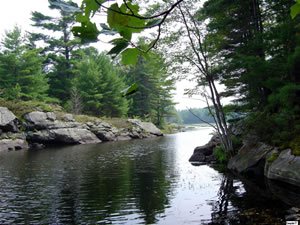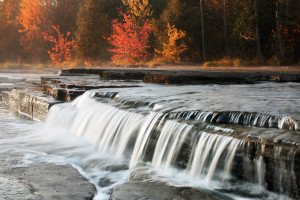Quinte Source Water Protection Area
 The Quinte Region Source Protection Area is based on the watershed boundaries of Quinte Conservation. This includes the watersheds of the Moira, Napanee and Salmon Rivers and all of Prince Edward County, an area of 5,921 square kilometres (km2) in eastern Ontario. There are approximately 117,000 people living in the region.
The Quinte Region Source Protection Area is based on the watershed boundaries of Quinte Conservation. This includes the watersheds of the Moira, Napanee and Salmon Rivers and all of Prince Edward County, an area of 5,921 square kilometres (km2) in eastern Ontario. There are approximately 117,000 people living in the region.
There are municipal drinking water supplies in this region at: Belleville, Point Anne, Deseronto, Napanee, Deloro, Madoc, Tweed, Wellington, Picton, Ameliasburgh, and Peat's Point.
The 11 municipal drinking water systems in the Quinte Region serve about 50% of the watershed's population. Seven of these systems are intakes from surface water and four are groundwater systems that have wells drilled into the underlying aquifers. The remaining population obtains water from private wells using groundwater; shore wells using surface water; or for some cottages, directly from a river or lake.
The Moira, Salmon and Napanee Rivers originate in the Canadian Shield. The northern areas of these watersheds feature rocky ridges, many wetlands and many popular cottage lakes. Forest cover is extensive and the area has large tracts of crown land. As the rivers move southward, on their way to the Bay of Quinte, they pass historic old mills, charming villages and the limestone plains dotted with farms. The County of Prince Edward has a number of small watersheds that drain from this largely agricultural area into Lake Ontario and the Bay of Quinte.
More information about source water protection in the region is available in the Quinte Source Protection Region Backgrounder.
History of Source Protection in the Quinte Region

May 2000 – Tragedy in Walkerton
Our drinking water comes from lakes, rivers, and bays or underground sources. Human activities can impact these water sources.
In May 2000, the municipal drinking water system for the community of Walkerton, Ontario was contaminated by a deadly strain of E. coli bacteria. Seven people died and thousands of other became ill from drinking the contaminated water. Many of these people now have chronic health issues. These terrible events demonstrate how vulnerable our drinking water can be when it is not properly managed and protected.
As a result of the tragedy in Walkerton the provincial government launched the Walkerton Inquiry, led by Justice Dennis O'Connor. Justice O'Connor's Walkerton Report called for many changes to how we manage drinking water in Ontario. A number of the recommendations emphasized the need for the protection of drinking water sources.
Justice O'Connor identified that drinking water is best protected through an approach that uses several barriers to prevent contamination from affecting our drinking water. This is called the 'multi-barrier approach'. Actions to prevent contamination include water treatment and distribution systems, training of water managers and water testing; but the first barrier is to protect our drinking water right at its source. From this recommendation, the term Source Protection was born. Click here for more on the Walkerton Report.
October 2006 – The Clean Water Act
The province passed the Clean Water Act in 2006 calling for each source protection area or region in Ontario to produce a local, science–based plan to protect sources of municipal drinking water.
2007 – Quinte Region Source Protection Committee
Under the Clean Water Act, 19 source protection regions were established across Ontario. Each region has a Source Protection Committee to create a local source protection plan to protect our drinking water. The Quinte Region Source Protection Committee is comprised of 21 multi-stakeholders from local municipalities, agriculture, industry, commerce, First Nations, environmental interests, and the general public. The Committee is supported by the Conservation Authorities' Boards of Directors, which under the Clean Water Act, are referred to as "Source Protection Authorities."
The Committee used scientific information and local knowledge from many working groups and the community throughout the source protection planning process in the Quinte Region.












